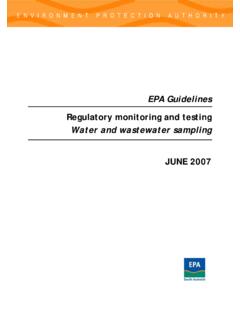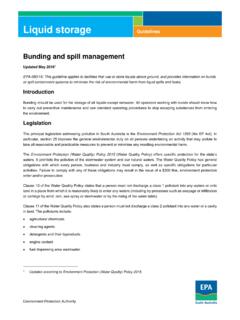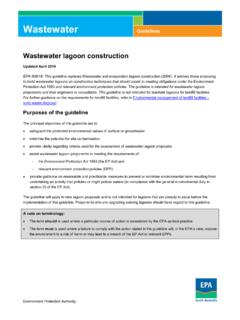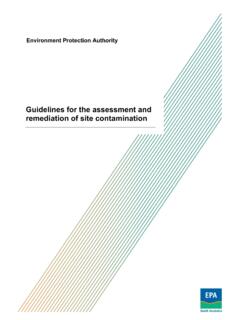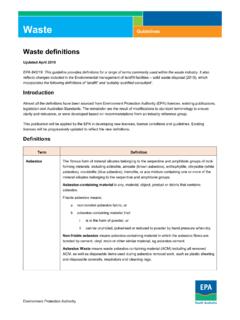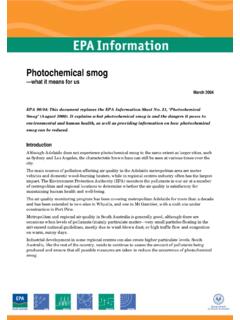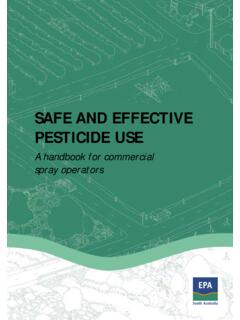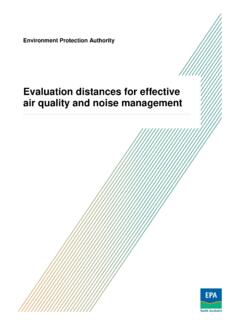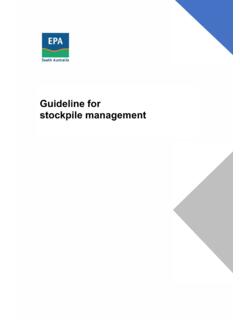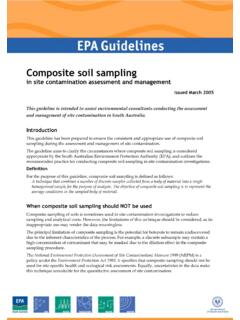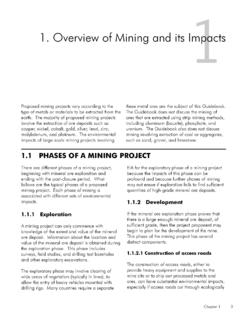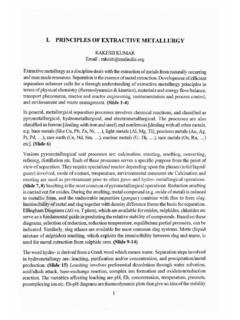Transcription of Safe and Effective Herbicide Use: A handbook for near ...
1 Addendum Safe and Effective Herbicide Use: A handbook for near-water applications In October 2007, the Environment Protection Authority released Safe and Effective Herbicide Use: A handbook for near-water applications. Due to an error realised since the release, the publication has the following change: On page 10, within Table 1. Herbicide classification, the middle column has been removed. This is due to a mistake in labelling Bipyridiliums ( Paraquat) as pre-emergent. Subsequent examination of the examples has lead to the EPA removing this column to remove ambiguity. Bipyridiliums are not pre-emergent.
2 They are a contact Herbicide that becomes tightly locked up when applied to soil. Updated April 2017 according to Environment Protection (Water Quality) Policy 2015. An updated version of this handbook is overleaf. A handbook for near-water applications SAfE And Effective Herbicide uSE Safe and Effective Herbicide USe A handbook for near-water applications 03 contentS introdUction Definitions 04 Your legal obligations 06 How to control weeds in riparian and aquatic areas 07 A planned approach 08 Consult and plan 11 SafetY firSt 1 Understanding labels 1 Accidents and emergency situations 14 Other considerations 14 before SPraYinG 17 Do you need to spray?
3 18 after SPraYinG Clean up Disposal Monitor, evaluate and follow up 3 reSoUrceS 5 Safe and Effective Herbicide Use: A handbook for near-water applications introdUction introdUction The purpose of this handbook is to advise South Australians on how to safely and effectively use herbicides to control weeds near waterbodies as part of a sustainable weed management plan for their properties. It focuses on application techniques and the selection of appropriate herbicides for the control of the weed species most commonly encountered near waterbodies. This handbook is one in a series of three. The others are: Safe and Effective pesticide use: a handbook for lifestyle landholders Safe and Effective pesticide use: a handbook for commercial spray operators.
4 The handbook for lifestyle landholders includes more general information on the use of pesticides. The control and management of weeds near waterbodies is a challenge faced by most landholders across South Australia. Waterbodies are particularly sensitive to Herbicide pollution, so the decision to apply herbicides in the vicinity must be taken with great care. Landholders should always consider non-chemical solutions as a preferred option before deciding to use herbicides. Weed control near waterbodies requires a long-term commitment to eradication, as the seed banks of many woody weed species ( blackberries, gorse) may remain viable for decades.
5 Weeds may also readily spread downstream along watercourses, making their control difficult. A gradual, planned approach to weed control, alongside a program to re-establish desirable native species, is necessary to ensure sustainable management of riparian areas. Landholders should always consider non-chemical solutions as a preferred option before deciding to use herbicides Safe and Effective Herbicide Use: A handbook for near-water applications 3 introdUction Remember that herbicides can enter waterbodies either directly through spray or spray drift, or they can move into waterbodies via surface water run-off or leaching and sub-surface draining Herbicides are designed to control pest plants ( weeds ) and are useful in many situations for Effective eradication.
6 It is important to realise, however, that many herbicides are toxic in aquatic ecosystems. Plants, invertebrates, amphibians and fish may be harmed when Herbicide moves into a body of water. Inappropriate use of herbicides may also cause significant risks to human health where water is pumped from a bore for domestic use, or flows to reservoirs. The EPA hopes that publication of this booklet will help the community to understand the link between issues of water quality and responsible use of herbicides. Remember that herbicides can enter waterbodies either directly through spray or spray drift, or they can move into waterbodies via surface water run-off or leaching and sub-surface draining.
7 Definitions What is a weed? There are a number of definitions available as to what constitutes a weed species. For the purposes of this booklet, a weed may be defined as any plant species which is not locally indigenous to the area in which it is located. It is true, however, that some locally indigenous species may become weedy , meaning they spread widely and cause problems for landholders. An example is the common reed, Phragmites australis, which in watercourses may trap sediment, resulting in flooding of surrounding land. For the control of locally indigenous species which become weedy , formal native vegetation clearance approval is required.
8 What is a waterbody? Waterbodies can include natural watercourses (streams, creeks, rivers), constructed drainage channels and ponds, natural 4 Safe and Effective Herbicide Use: A handbook for near-water applications introdUction wetlands, ponds, lagoons, reservoirs and lakes. Waterbodies can be categorised as: Permanently inundated/aquatic/perennial. These have water all year round ( spring-fed streams and wetlands, lagoons and reservoirs). Occasionally inundated/intermittent. These have water some time of the year ( occasionally flooded floodplains, backwaters, some wetlands, major riparian channels that drain through catchments).
9 Rarely inundated/ephemeral. These are areas that rarely contain water ( areas that flood on rare occasions). Whatever the type, never spray herbicides over an open body of water! What is riparian land? Riparian land can be defined as any land that adjoins, directly influences, or is influenced by a body of water at any time of the year. What is riparian vegetation? Riparian vegetation is vegetation located on riparian land. This vegetation plays a vital role in maintaining a healthy aquatic ecosystem. A healthy watercourse will have a relatively stable stream bed and banks. The stream bed and banks will usually be vegetated and provide habitat for a wide variety of birds, fish, frogs, lizards and other animals.
10 Riparian vegetation also assists in binding sediment and preventing watercourse erosion during periods of high flow. A healthy riparian zone contributes to maintaining water quality as the riparian vegetation filters surface water entering the watercourse. A healthy riparian zone contributes to maintaining water quality as the riparian vegetation filters surface water entering the watercourse Safe and Effective Herbicide Use: A handbook for near-water applications 5 introdUction As a landholder you have legal obligations to protect the environment from harm What is a Herbicide ? Herbicides are chemical substances or mixtures of substances intended for killing pest plants.
